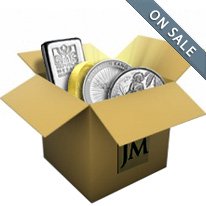Free Silver Price Widget For Your Website
This feature is only supported in the desktop browsers. Please visit this page in your desktop browser to retrieve the widget.
Share live silver prices with your website followers or on your blog, using our free silver price widget. To get started, please select one of the size dimensions from the drop-down menu below, and copy the code from the Widget Code text box and paste it into the desired position in your page. If you have any trouble, please contact us at support@jmbullion.com.
Widget Preview
Widget Code
Silver Prices in Hungarian Forint
Silver is often associated with U.S. Dollars, but the white metal can be bought or sold in any currency. If you were looking to buy silver jewelry, coin or bullion in Hungary, for example, chances are that the price of silver would be quoted and traded in Hungarian Forint. Prices may also be quoted in other currencies as well, and will typically be quoted per ounce, gram and kilo.
The Hungarian Forint is the official currency of Hungary. The forint got its name from the city of Florence, which from 1252 minted gold coins known as fiorino d’oro. The forint was introduced in 1946 following a period of hyperinflation that left the previous currency essentially worthless. The forint is technically made up of 100 filler, similar to cents, although these coins have not been produced in almost two decades.
After the Hungarian Forint was introduced in 1946, its value was relatively stable for many years. The value of the currency began to slide, however, in the 70s and 80s. The Hungarian Forint has been on solid footing since 2000, and its relative strength may present a challenge for the country’s exporters.
The Hungarian Forint has been on a floating exchange rate since February 2008.
Silver Pricing in Hungarian Forint
The price of silver can be affected by many different potential influences regardless of geographical location. Silver derives demand from both investors as well as industry, and this industrial demand could potentially fuel a divergence between the price of silver and the price of gold.
Some of the key economic influences on the price of silver include:
- Investment demand
- Industrial demand
- Currency markets
- Inflation levels
- Monetary policy
- Overall risk appetite or aversion
Silver is used today in many areas of industry, including electronics, health care, solar energy and more. More and more applications for silver may potentially be discovered, and rising demand could potentially have a significant impact on prices. In addition, any issues concerning silver mining or other possible supply issues could potentially have a significant impact on the price of silver.
Silver prices are set by various pricing mechanisms, and can potentially see wild swings and fluctuations as well as periods of relatively sideways trade. Like other commodities, the basic laws of supply and demand fuel price action.
The Hungarian Mint
The Hungarian Mint has a long history of quality and craftsmanship. The mint first produced the silver denar under the country’s first King, St. Stephen, in 1001. The mint was moved to Budapest in 1925, the city in which it is located today. At that time, however, it was known as the Hungarian Royal Mint.
Following World War II, the mint operated under the name Hungarian State Mint. The mint has been owned by the Hungarian National Bank since 1998.
The modern mint produces different coins issued by the central bank as well as commemorative coins and medals. The Hungarian Mint has a tendency to mint coins that celebrate various key events, dates and figures in the nation’s history.
In 1948, the mint produced the first collectable forint coin celebrating the 100th anniversary of the 1848-49 revolution and war of independence.
The 1956 silver series comes in denominations of 10, 20 and 25 forint and depicts the National Museum, the Chain Bridge of Budapest and the Hungarian Parliament. These coins were issued in celebration of the 10 year anniversary of the introduction of the country’s forint currency system. The maximum mintage of these coins was just 22,000 pieces, and they may be highly collectable.
Hungary’s main exports are transport equipment, machinery, chemicals, iron and steel and consumer goods. Like other exporters, the industrial need for silver in Hungary could potentially expand as more applications become viable.
Silver may also potentially become more popular with investors. Silver may potentially add a degree of diversification to an investment portfolio, and unlike paper currency carries no counterparty risk.
Hungary’s monetary policy is controlled by the Hungarian National Bank. By law, the bank’s objective is to promote price stability. The central bank looks to also achieve and maintain a low but positive rate of inflation.
World Silver Prices
- Arab Emirates Silver Prices
- Australia Silver Prices
- Brazil Silver Prices
- Canada Silver Prices
- Chile Silver Prices
- China Silver Prices
- Czech Republic Silver Prices
- Denmark Silver Prices
- Europe Silver Prices
- Hong Kong Silver Prices
- Hungary Silver Prices
- India Silver Prices
- Indonesia Silver Prices
- Israel Silver Prices
- Japan Silver Prices
- Malaysia Silver Prices
- Mexico Silver Prices
- New Zealand Silver Prices
- Norway Silver Prices
- Pakistan Silver Prices
- Philippines Silver Prices
- Poland Silver Prices
- Russia Silver Prices
- Singapore Silver Prices
- South Africa Silver Prices
- South Korea Silver Prices
- Sweden Silver Prices
- Switzerland Silver Prices
- Taiwan Silver Prices
- Thailand Silver Prices
- Turkey Silver Prices
- United Kingdom Silver Prices
- United States Silver Prices










